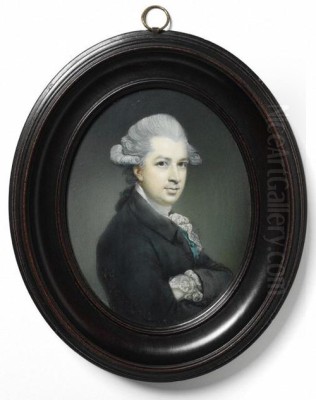
Richard Crosse (1742-1810) stands as a significant figure in the history of British art, particularly celebrated for his exquisite portrait miniatures. Active during the latter half of the 18th century, a period often considered a golden age for this intimate art form, Crosse achieved remarkable success and recognition despite facing the profound challenge of being deaf and unable to speak from birth. His work, characterized by delicate precision and a distinctive palette, earned him prestigious patronage, including members of the British Royal Family, and secured his place among the leading miniaturists of his time.
Early Life and Artistic Formation
Born on April 24, 1742, in Knowle, near Cullompton in Devon, Richard Crosse hailed from a family of country gentry. His father was a lawyer, providing a background of relative comfort and status. A pivotal aspect of Crosse's life was his congenital deafness, which also prevented him from learning to speak. This condition profoundly shaped his experience of the world and his means of communication, relying on gestures and the assistance of his family members throughout his life.
Despite these challenges, Crosse displayed an early aptitude for art. His family supported his artistic inclinations, providing him with a private education focused on developing his talents. At the young age of 16, he moved to London to pursue formal art training. He studied at William Shipley's drawing school in the Strand, a hub for aspiring artists, and became associated with the Society for the Encouragement of Arts, Manufactures and Commerce (often known simply as the Society of Arts), based in London. This early exposure to the London art world was crucial for his development.
Artistic Style and Technique
Richard Crosse specialised in portrait miniatures, primarily executed in watercolour on ivory. This medium, popular for its luminous quality and ability to capture fine detail, suited Crosse’s meticulous approach. His style is noted for its refinement, lifelike quality, and remarkable precision. He possessed an exceptional ability to capture the likeness and character of his sitters within the small confines of the miniature format.
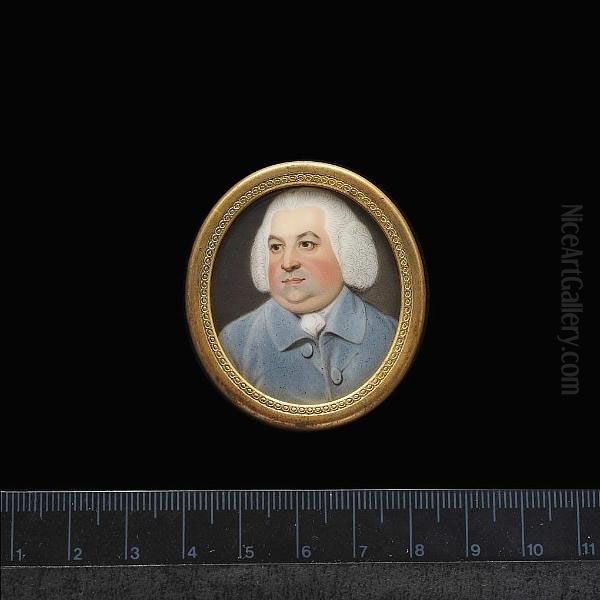
A distinctive feature of Crosse's work is his colour palette. He often employed subtle greenish-blue tones, particularly in the backgrounds or shaded areas of the flesh, lending a cool, delicate feel to his portraits. These were frequently complemented by faint, carefully applied traces of red or pink pigment, adding warmth and vitality to the complexion. This characteristic use of colour helps distinguish his work from that of some of his contemporaries.
Art historians note the influence of Jeremiah Meyer (1735-1789), another prominent miniaturist working in London, on Crosse's style. Crosse appears to have inherited or adapted Meyer's clear, graphic approach to defining form, resulting in miniatures that are both elegant and sharply observed. His technical skill was widely acknowledged, allowing him to render textures, fabrics, and details like hair and jewellery with impressive accuracy.
A Successful Career and Royal Patronage
Crosse established a successful practice in London, operating from his studio in Henrietta Street, Covent Garden, for many years. His talent quickly gained recognition, and he began exhibiting his work regularly at London's leading art institutions. From 1760 to 1796, he showed numerous miniatures at the Society of Artists, the Free Society of Artists, and, most prestigious of all, the Royal Academy of Arts.
His clientele grew to include prominent members of society and the aristocracy. His skill attracted the attention of the Royal Family, leading to the significant appointment as Painter in Enamel to King George III. This prestigious title underscored his standing in the art world. Among his notable sitters were the Prince of Wales (the future King George IV), the Duke of Cumberland, and the Duke of Dorset, reflecting his favour among the highest echelons of British society. His popularity endured for several decades, making him one of the most sought-after miniaturists of his generation.
Notable Works
While many of Crosse's miniatures are held in private collections, several key works reside in public institutions, offering insight into his artistry.
A significant example is his Self-portrait, housed in the Victoria and Albert Museum, London. This work showcases his ability to capture a sensitive and introspective likeness. Another version or related self-portrait is noted as being in the collection of the Royal Albert Memorial Museum (RAMM) in Exeter, acquired through the Sir Harry Veitch Bequest Trust Fund in 1962. These self-portraits provide a valuable glimpse of the artist himself.
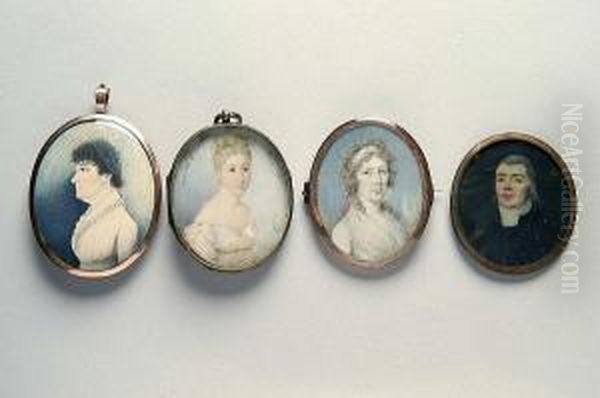
Another representative work often cited is titled 'A Gentleman'. One such miniature, depicting a man in a distinctive gold-trimmed velvet coat and wearing a powdered wig or his natural hair dressed high, is held by the British Deaf History Society's museum and archive. This piece exemplifies his skill in rendering costume details and capturing the sitter's personality, typical of his commissioned work for the gentry and aristocracy.
Contemporaries and the Artistic Scene
Richard Crosse worked during a vibrant period for British art, particularly portraiture. London was the epicentre, bustling with artists competing for commissions and recognition. Crosse navigated this competitive landscape successfully, establishing his niche in the specialised field of miniature painting.
He shared the artistic stage with giants of large-scale portraiture like Sir Joshua Reynolds (1723-1992), the first President of the Royal Academy, whose grand manner portraits defined the era, and Thomas Gainsborough (1727-1788), Reynolds' great rival, known for his fluid brushwork and sensitivity in both portraiture and landscape. Other major portraitists included George Romney (1734-1802), whose elegant style was immensely popular. The era also saw prominent female artists like Angelica Kauffman (1741-1807), a Swiss-born painter and founding member of the Royal Academy.
Within the specific field of miniature painting, Crosse faced stiff competition. Richard Cosway (1742-1821), his exact contemporary, was perhaps his most famous rival. Cosway, known for his flamboyant style and fashionable clientele (he was also favoured by the Prince of Wales), presented a contrast to Crosse's more reserved approach. Other leading miniaturists included John Smart (c. 1740-1811), renowned for his precise and powerful miniatures, who spent a significant part of his career in India.
George Engleheart (1750-1829) was another highly prolific and successful miniaturist, known for his distinctive large eyes and meticulous finish. Ozias Humphry (1742-1810), also Crosse's contemporary, enjoyed considerable success before his eyesight failed; he too worked in India for a time. The brothers Andrew Plimer (c. 1763-1837) and Nathaniel Plimer (1757-1822) developed their own recognisable, often more decorative, styles. Samuel Shelley (c. 1750/56-1808) was noted for his graceful compositions, often featuring multiple figures. William Wood (1769-1810) was another skilled practitioner active towards the end of Crosse's career.
Furthermore, Crosse was not the only deaf artist achieving prominence. He is often mentioned alongside Sampson Towgood Roch (c. 1757-1847) and Charles Shirreff (c. 1750-c. 1831), both successful deaf miniaturists active in London, Bath, and elsewhere. They competed within the same high society circles, demonstrating that artistic talent could transcend physical disability even in the demanding social environment of the 18th century.
Personal Life and Later Years
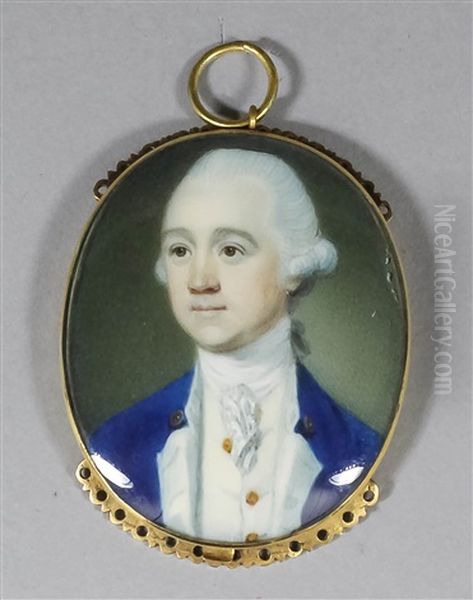
Richard Crosse's personal life was relatively quiet, perhaps partly due to his deafness. He never married. An anecdote often recounted concerns his engagement to a Miss Cobley, who was also his cousin. Reportedly, Crosse broke off the engagement, or refused her proposal, an event considered somewhat controversial at the time; she subsequently married another man. Crosse remained a bachelor throughout his life.
After a long and successful career spanning nearly four decades, Crosse retired from painting around 1798. He left London and returned to his native West Country. In his later years, he reportedly became increasingly reclusive. He went to live with his brother in Wells, Somerset. His lifelong inability to speak meant he continued to rely on gestures and the understanding of those close to him for communication.
Richard Crosse died in 1810 at Knowle, the place of his birth, leaving behind a significant body of work that testifies to his dedication and artistry.
Legacy and Art Historical Significance
Richard Crosse is highly regarded by art historians as one of the foremost English miniaturists of the 18th century. His work is appreciated for its technical brilliance, psychological insight, and the distinctive, delicate aesthetic he cultivated. He successfully navigated the competitive London art world and secured elite patronage despite the significant barrier of his deafness, a testament to his talent and determination.
His contribution places him firmly within the great tradition of English miniature painting, a lineage stretching back to artists like Nicholas Hilliard (c. 1547-1619) in the Elizabethan era and continuing through numerous practitioners up to his own time, including contemporaries like Horace Hone (1754/56-1825). Crosse upheld the high standards of the craft while developing his own recognisable style.
His miniatures serve as valuable historical documents, capturing the likenesses of key figures of the Georgian era and reflecting the tastes and fashions of the time. They remain sought after by collectors and are represented in major museum collections, including the Victoria and Albert Museum, the Royal Collection, and regional museums like Exeter's RAMM. His life story also serves as an inspiring example of overcoming adversity to achieve excellence in the arts.
Conclusion
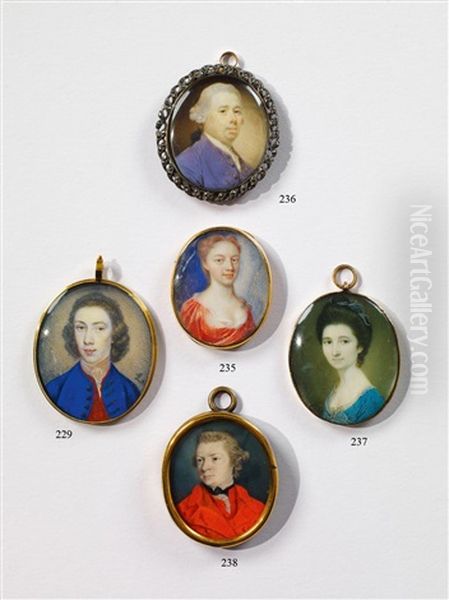
Richard Crosse's legacy is that of a master craftsman and a sensitive portraitist who excelled in the demanding art of the miniature. His ability to convey character and status with such precision and delicacy, often employing a subtle and unique colour sense, marks him as a standout artist of his generation. Despite living and working in silence, his art spoke volumes, capturing the faces of Georgian England for posterity and securing his enduring reputation in the annals of British art history.